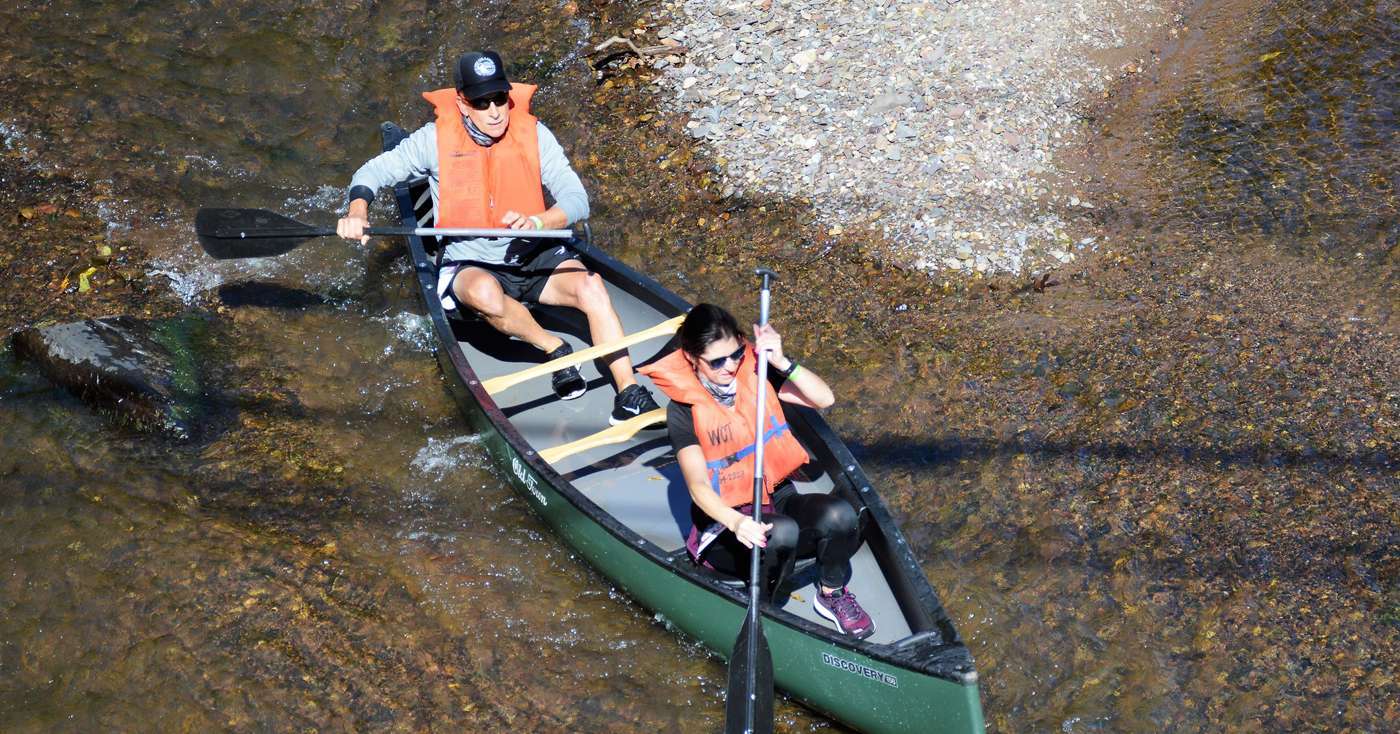One thing you can count on when you take up canoeing is that at some point you’ll end up in the drink, clinging to your half-submerged craft. And none of us looks forward to the sometimes long swim; towing or pushing our canoe to shore. There’s a reason canoe rolls were invented. But rolling your whitewater playboat isn’t always possible and rolling isn’t feasible at all for most types of canoes. Therefore, it’s a good idea to have a few canoe rescue skills up your sleeve. The following techniques will work for all types of canoes in both river and lake situations.
Canoe-Over-Canoe
A solo paddler or a tandem crew can perform this technique. Any gear from boats being rescued should be first handed to the rescue boat and stowed below gunwale lines.
The rescue canoe then maneuvers so it is 90 degrees to the overturned craft. The paddler or paddlers of the dumped canoe should swim to the end of their canoe that is farthest away from the rescue canoe and push down to help break the suction. This facilitates the rescuer lifting the end of the overturned canoe up on to the gunwales of his canoe. At this point, the paddlers of the canoe being rescued should swim to opposite ends of the rescuer’s canoe and hold on.
The rescuer (or rescuers in the case of a tandem crew) will now slide the canoe upside down across the gunwales amidships until it is centered. The canoe is then rolled upright and slid back into the water. The now empty canoe is brought alongside the rescuer canoe and the gunwales of both canoes are hand clamped while the victims crawl back in one at a time.
Canoe-over-canoe can be performed with two dumped canoes as well. The canoe to be emptied of water first is slid right side up until it is centered over the submerged canoe then flipped upside down to empty it. The big difference is the first paddler getting back in the canoe. This is accomplished by a victim being on both sides of the empty canoe at the mid sections. While one does a seal flop with hard flutter kick the other steadies the canoe. For people who don’t have the strength to seal flop and flutter kick back into the canoe, a rescuer can put a sling with multiple loops over the grip of a paddle and hand clamp the shaft of the paddle at both gunwales (see diagram).
Boat Bump
The boat bump is primarily a river rescue technique. It is used to push canoes into eddies so a canoe-over-canoe rescue can be performed, or to push the canoe and victim all the way to shore.
Before starting a boat bump the victim needs to be on the upstream end of the canoe swimming the boat on a ferry angle toward an eddy or shoreline. The rescuer paddles in 90 degrees to the victim’s boat and pushes with the bow of his canoe just upstream from amidships. Maintaining good angle, along with powerful strokes, make the boat bump effective. If done poorly, the rescuer can be more of a liability than a helping hand.
Paddling Awash
If you dump your canoe in flat water and another boat is not present, one way to reach shore is paddling awash. It works best if the canoe has good primary stability. Simply crawl back in your swamped canoe and sit on the bottom of the craft and paddle it to shore. This is much easier than trying to pull or push the canoe while swimming. This obviously doesn’t work in whitewater.
Swimming the Canoe Awash
If you dump your canoe in whitewater and there’s no other boat around, swimming your canoe to shore is your only option. Get to the upstream end of your canoe as quickly as possible; never be downstream from your canoe! Look downstream and evaluate hazards. If you have a partner make sure he or she gets upstream as well. If there are no life-threatening obstacles, like strainers, angle your canoe to a correct ferry angle and swim it upstream until the current pushes you into an eddy or shoreline. This should be perfected early on in your whitewater paddling career.
Roll Out
This is a good technique for self rescue in flat water. The canoe needs to be unloaded first. The victim positions himself or herself amidships with the canoe floating in the upright position. The victim then depresses the near gunwale about 6 to 12 inches below the surface and frog kicks the canoe forward. Before momentum forward is lost the victim lifts the near gunwale until it is above the water surface. A rhythm is developed repeating this sequence until the canoe is empty. This can be done with a 16-foot canoe in as little as 25 seconds.
Throw Bag Rescue:
Use a throw bag station whenever running a rapid where the potential for a rollover is possible. Careful choice of throw bag location is important. The rescuer needs to be aware of where the victims and canoe will end up once successfully secured to the rescue line. It’s also important that the person managing the throw bag has lots of practice in choosing a good location for the throw bag station, throwing the rescue line and anchoring the rope once the victims have grasped it. Before the rescuer throws the bag, a whistle should be blown to alert the victims. An inexperienced rescuer is more of a liability than an aid.
Last modified: January 2, 2023


